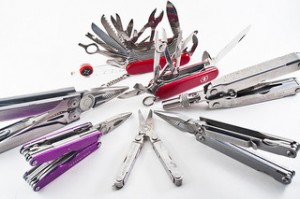12 Essentials for your Emergency Tool Kit
Most riders dread the thought of a motorcycle breakdown. Not only are they inconvenient and potentially costly, they can create safety and security risks. Routine maintenance and pre-ride inspections go a long way in preempting them. While you can’t be prepared for, or even imagine, every possibility, it’s wise to be prepared for the most likely.
 The longer your tour and the more remote your area of travel, the more important it is to carry these essentials. They’re compact, lightweight and any inconvenience in packing them is offset by their potential benefit.
The longer your tour and the more remote your area of travel, the more important it is to carry these essentials. They’re compact, lightweight and any inconvenience in packing them is offset by their potential benefit.
12 Essentials for your Emergency Tool Kit
- Multi-headed screwdriver. Small and compact, it comes in handy for a myriad of uses both on and off the bike.
- LED Flashlight. Whether you’ve run out of daylight and need to check a map or want to check the wear on your brake pads, it’s invaluable.
- Motorcycle jumper cables. I needed to use these once during a group ride. I shut of the engine with my kill switch and left my ignition on, then went on a winery tour. When I came out my battery was dead, but help was available and I was soon on my way.
- Assorted Allen keys. The essentials should be in your bike’s tool kit. Check to make sure you’ve got the sizes you’re most likely to need.
- Assorted box and crescent wrenches. As with Allen keys, check your tool kit for those most likely to be needed for your bike.
- Fuel line or siphoning hose. Running out of gas is usually avoidable with good planning; yet it happens. A gas station you thought was out in the middle of nowhere was closed up and you need to continue. You won’t go anywhere without fuel.
- Multi-tool. Another handy gadget that can make a big difference between go and no-go.
- Fasteners. Tie-wraps, electrical tape, duct tape. Engine vibrations and ordinary use is tough on brackets, fittings and cable housing. These can get you by in a pinch.
- Spare fuses. A blown fuse can leave you stranded; at a minimum, it is inconvenient. I learned this after blowing a fuse on my heated gear during a long-distance cold-weather ride. Had I not had an appropriate fuse with me, I’d have had to delay travel until I could find one.
- Replacement brake light and headlights. Most times this is an easy on-the spot fix – and you’ll have the tools above which help you remove the lenses.
- Roadside assistance. Invest in a CAA Plus, AMA Membership Card – any that cover you and your bike for emergency towing. When you invest in AMA, you’re also investing in protecting your freedom.
- Owner’s manual. While it may not have a great deal of detail, it will have the basics, including specifications for your bike. It’s great to have while traveling – your bike may decide to need maintenance well out of range of any OEM service shops. I tuck mine under the seat so it’s always with the bike.
While obviously important for solo riders, it’s good to carry them all the time, even when riding with others. If anyone has a breakdown, it affects the whole group.
Getting to know your bike through routine maintenance and model-specific online forums can acquaint you with the problems you’re most likely to have. Carrying these essentials in your emergency tool kit can help prevent unexpected events from interfering with your ride.

Is there a kit you can buy with most if not all these tools?
It would be nice if there was Bill – but I’m not aware of one. You’ll need to create your own. Everyone has their own favorite “essentials” – but these cover most situations for anyone.
Safe travels!
Liz